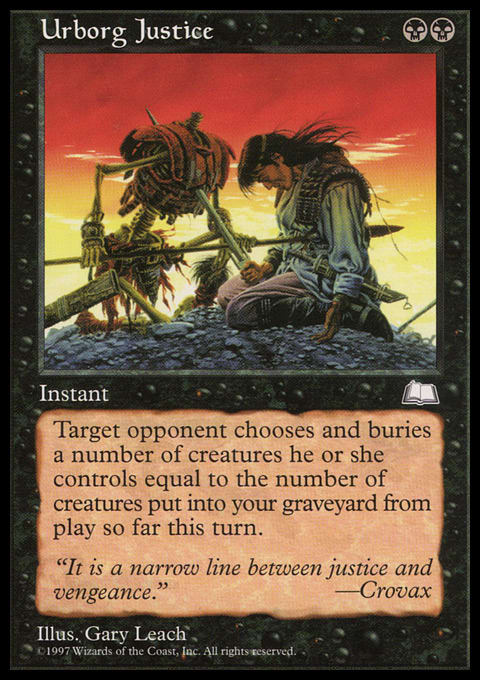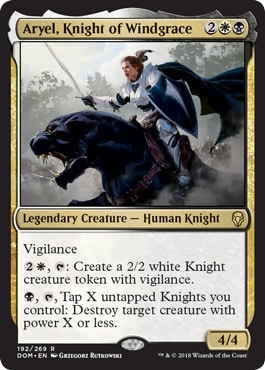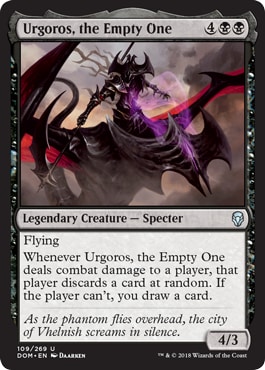I've always loved the weird, creepy, crawly, and spooky, so it's not particularly surprising that I like Urborg in its many forms, and love contemporary Urborg in particular. Urborg today is full of fun ghouls of varied appearance, living in the shadow of Urborg's volcanic mountains and polluted swamps. Apparently the creative team for Dominaria wanted to give Black some diversity and playfulness, and drew upon Hayao Miyazaki films (like, presumably, the beloved Spirited Away, a film full of gloriously strange spirits) to create the contemporary look of the island. Urborg's many ghosts and zombies and horrors seem to have developed civilization and turned the swamp into a pretty fun place to be.
Fun, that is, except for all the problems Urborg has traditionally had: domineering lich lords and their thuggish agents shoving around the small business owner, and assorted less civilized remnants of various disasters wandering the bogs, eating dead and undead alike. I guess Urborg still isn't what you'd call a great place to live. Really, it never has been, or at least it hasn't been since the days of the Brother's War. Apparently the island used to be a forest full of hot panther warriors (most famously Lord Windgrace). Then Urza blew up a continent, and, in the process, Urborg's tectonic plate must've been destabilized because the whole island sank and became a festering swamp with a bunch of volcanoes in the middle.
Since then, Urborg's history has been pretty dismal. The city of Urborg, for example, doesn't exist anymore. Sometime before the Ice Age, its lich lord ruler, Nevinyrral, blew the whole thing up lest it fall into the hands of an invading army. The whole region, the Burning Isles, is lousy with necromancers and lich lords, actually. Apparently the whole impetus for the evil wizard Kaervik's invasion of Jamuraa during the events of Mirage block was there were so dang many evil wizards in the Burning Isles that he just kept getting shoved around by other necro-jocks.
Then, of course, an entire other plane got dropped onto Dominaria and a big Phyrexian-filled Stronghold ended up in the middle of Urborg's biggest volcano, and THEN, as if that wasn't enough, Phyrexia's Black mana death cloud and chief men's rights activist straight up died right over the island. This left it even more toxic than before, full of wrecked Phyrexian ships and corpses. Urborg seemed doomed to remain a huge blight on the face of Dominaria, ruled by tyrannical wizards and haunted by nightmare creatures forever. It's hard not to look on Barrin's suggestion during the Invasion that the defenders of Dominaria should just abandon the region to Phyrexia with a little sympathy.
There's some moments within history that suggest a different path for Urborg, though. It's not one without Urborg's monsters, mind. The monsters would still be there . . . but they'd be the good guys.
We've got a few models to go off here, though they're not without their flaws. The most successful is probably Lord Windgrace, a panther warrior from the days when Urborg was still forest. A powerful planeswalker, Windgrace never stopped fighting for his people and his homeland against generations of petty lich lords. He defended Urborg from Phyrexia during the Invasion, and he defended Urborg from the ravages of the time rifts during the Mending, infusing the very land with his essence. His acolytes continue his work into the present, battling Phyrexian remnants and Cabal agents alike, and it has been speculated that he still guides heroes on Urborg.
What's interesting to me about Windgrace's champions is that they remain at least partly Black-aligned. Oh sure, Aryel is ![]()
![]() , but common Acolytes are Black. That's kind of interesting. It suggests there might be a way forward for Urborg that keeps some of the basic qualities of the land without slipping into the kind of evil the region is practically synonymous with.
, but common Acolytes are Black. That's kind of interesting. It suggests there might be a way forward for Urborg that keeps some of the basic qualities of the land without slipping into the kind of evil the region is practically synonymous with.
Crovax is probably Black-aligned as well. We don't, unfortunately, get an outright card for him until after he goes all vampiric, but from his cards in Weatherlight it seems pretty clear he's meant to be the Black-aligned member of the Weatherlight, complimenting and evening out the crew, which covers the other four colors and colorless. Early on in the story he's not evil, though there's hints at the darkness to come. He's mostly just really depressed. He's a product of the violence of Urborg and Phyrexia, but seems to have come out of that violence -- violence that cost him his whole family -- keenly conscious of the way even ostensibly noble causes can turn sour. This does not, tragically, save him, but there's a hint in his early character, I think, of a different kind of Urborg Justice.
That idea emerges most clearly through the character of Lord Dralnu. A lich lord during the time of the Invasion, Dralnu famously ruled the underground city of Vhelnish, possibly for a few hundred years, though we've only got some of his own vague statements to draw on here. Dralnu made an ultimately ill-fated alliance with the army of Metathran soldiers created to fight Phyrexia. Everything worked out pretty well for a while, until the minotaur general Grizzlegom put an axe through his head. In fairness, Dralnu had just infected the Metathran general Agnate with a wasting disease, with the end goal of, apparently, conquering Urborg with the combined coalition army and a zombified Agnate.
Ok, yeah, admittedly Dralnu's a bit of a mess. But, in fairness, so is the Invasion Cycle, from a thematic standpoint. I'm going to delve more into the particular weirdness of Dralnu's story arc at some point in the near future but for now I'll simply concede that Dralnu was not, apparently, a totally upstanding guy.
And yet, contemporary Urborg sure seems a lot like what he was ostensibly trying to achieve in Vhelnish.
Vhelnish before Dralnu was ruled by a necromancer queen (or possibly a whole succession of necromancers) who used the great cavern city as a place to display undead trophies. Dralnu was one of these trophies -- he claims he was a powerful warrior before he was killed and raised as a servant by this nameless necromancer. He learned the necromantic arts, overthrew his mistress, and treated Vhelnish as an actual city, a place where the dead could pass their unlives and work, no longer simply shambling playthings but beings with some sort of purpose.
It's not clear how much of this is sincere and how much is bogus. We only get Dralnu's account of his own work in the city, and that itself is filtered through Agnate's deeply morbid mind. Agnate did, after all, just have to kill his psychically linked genetic twin Thaddeus after his fellow general was vivisected by the Phyrexians. The guy's not in the best state of mind to judge Dralnu's sincerity.
Nevertheless, Dralnu does speak of his rebellion in Vhelnish in terms of liberation, freeing the dead from necromantic domination. Vhelnish certainly does seem more like a functioning city of the dead than the simple automaton horrors we see in, say, Bolas's army of Eternals. Is it possible there's something to what Dralnu claimed?
I've touched before on the problem of actually lining up the broad generalizations of the color pie with specific narratives. Subservience might be Black in some circumstances; rebellion might be Black in others! I think there's room, therefore, to look at some of the past and present inhabitants of Urborg and see the seeds of Black rebelliousness.
Are not the ghouls and ghosties of Urborg oppressed, after all, by their "filthy rutting lich-lord" masters? Wouldn't even many of the mortals -- humans like Crovax's family, or the various human and pantherfolk acolytes of Windgrace -- benefit from a change to the status quo? Urborg's native inhabitants traded necromancers for lich lords for Phyrexian puppet rulers for Cabal agents. Even now, Vhelnish, the city Dralnu hoped would be a refuge for the undead, suffers under the domination of Urgoros, one of Belzenlok's pet horrors!
Isn't it time that the ghouls of Urborg had the opportunity to rule themselves, a chance to try for what everyone wants -- civilization?
Let's go at the question from another perspective. What color are unions? I think it's easy to default to White as the answer here. Unions are inherently an example of collective action, workers uniting as one political body in order to defend their interests. Ah, but there's the odd wrinkle to it: a union forms because workers need some way to defend their interests, their self-interest, against the opposed interests of bosses, who seek to minimize the cost of labor and maximize profit. Isn't that quintessentially Black? The means might be White, but the goal is one of entirely respectable selfishness.
I'm pretty sure Planesift was the first Magic novel I ever read. (Yeah. Don't talk to me about it being hard to understand the storyline!) I was like 12 so I didn't really have the cognitive development or the lit crit knowledge necessary to make sense of Dralnu's story at the time, even setting aside some of the weirder aspects of the Invasion cycle. But man, Dralnu's story stuck with me. I immediately empathized with this lich who was just trying to make a better world for his kind. And besides, the idea that zombies and ghouls and ghosts could be more than just mindless antagonists. For someone into cryptids and the supernatural, the idea of a whole hidden civilization of weird monsters appealed greatly.
I'm sure Skulltown and Vhelnish and their inhabitants have their problems. Still, it's incredibly cool to see, after all these years, something of what Dralnu was trying to do live on in Dominaria. Nothing has to stay a festering bog forever. Or, at least, if it does, the weird monsters that live there can be given the chance to make it a thriving, more equitable, cool looking festering bog. They can find their own form of Urborg Justice.



























